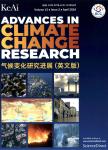Changes in net ecosystem exchange of CO_(2)in Arctic and their relationships with climate change during 2002-2017
作者机构:Key Laboratory of Western China's Environmental Systems(Ministry of Education)College of Earth and Environmental SciencesLanzhou UniversityLanzhou730000China Southern Marine Science and Engineering Guangdong Laboratory(Zhuhai)Zhuhai519000China Cryosphere Research Station on the Qinghai-Tibetan PlateauState Key Laboratory of Cryospheric ScienceNorthwest Institute of Eco-Environment and ResourceChinese Academy of SciencesLanzhou730000China University Cooperation of Polar ResearchBeijing100875China Geographical FacultyLomonosov Moscow State UniversityMoscow119991Russia
出 版 物:《Advances in Climate Change Research》 (气候变化研究进展(英文版))
年 卷 期:2021年第12卷第4期
页 面:475-481页
核心收录:
学科分类:07[理学] 0707[理学-海洋科学] 070601[理学-气象学] 0706[理学-大气科学]
基 金:the National Key Research and Development Program of China(2019YFA0607003) the National Natural Science Foundation of China(41941015,32061143032) the West Light Foundation of the Chinese Academy of Sciences,and Russian Fund for Basic Research(18-05-60080) State topic N AAAA-A16-116032810095-6
主 题:Arctic Climate change Permafrost Carbon flux Ecosystem Eddy covariance
摘 要:Arctic wanning leads to permafrost degradation,which can increase ecosystem respiration and release more greenhouse gas into the ***,climate warming also promotes the plant growth and increases carbon ***,it is largely unknown about the carbon budget and their responses to climate change in the Arctic *** this study,to investigate the seasonal and annual net ecosystem carbon exchange(NEE),we collected 71 observation stations for net ecosystem exchange(NEE)of CO_(2)in the high latitude permafrost regions during *** results showed that the annual NEE was-8.2±4.1 g CO_(2)m^(-2)d^(-1)for forest,-3.3±2.6 g CO_(2)m^(-2)d^(-1)for shrub,-4.8±4.1 g CO_(2)m^(-2)d^(-1)for grassland,-3.6±3.0 g CO_(2)m^(-2)d^(-1)for wetland and 0.02±0.62 g CO_(2)m^(-2)d^(-1)for tundra,*** 2002 to 2017,the CO_(2)emissions of grassland(carbon source)showed a decreasing trend,and the CO_(2)assimilation of shrub and forest(carbon sink)has been *** wetland and tundra are shifting from carbon sources to *** were great variations in temperature sen-sitivities(Q10)of NEE in different seasons,with larger values in winter and lower values in *** findings indicate that the Arctic terrestrial ecosystem presently acts as a carbon sink,while there is a possibility that future warming,especially the warming in winter,may decrease the carbon sink of the Arctic terrestrial ecosystem.



